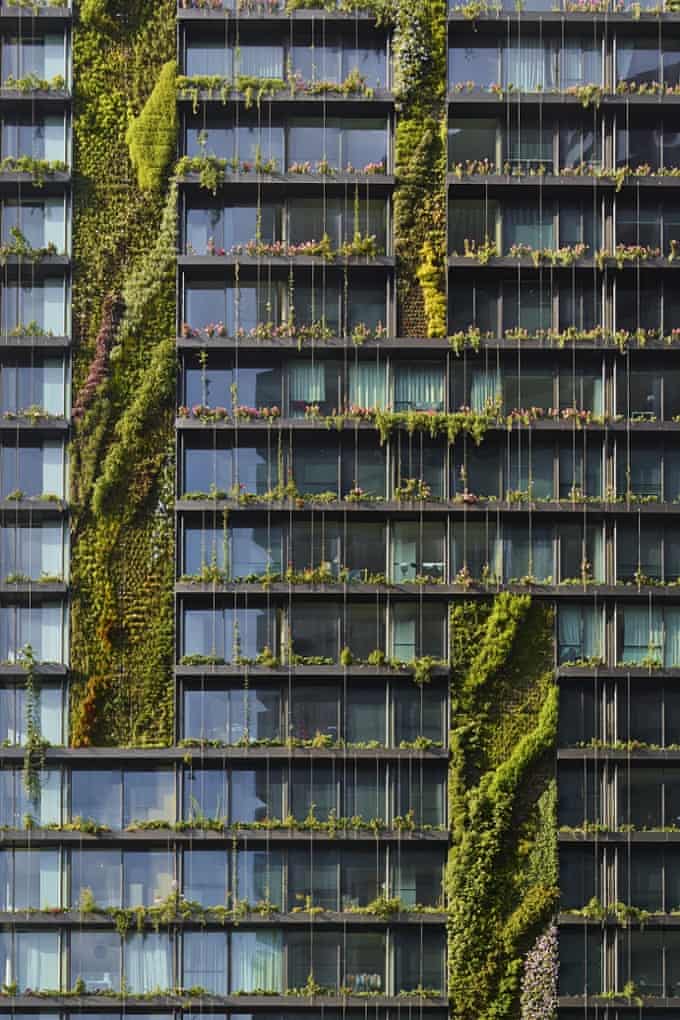Source: theguardian.com
Published: November 11, 2014

One Central Park, which was named the best tall building in the world, has a heliostat that at night turns into an LED artwork. Photograph: Murray Fredericks/PR
An apartment block in Chippendale impressed jurors for its sustainable design concepts, including green walls and water recycling program
A residential building in Sydney has been named the best tall building in the world. One Central Park by French design group Ateliers Jean Nouvel and Australia’s PTW, beat 87 other international entries to top the list, and was commended for its visible use of green design.
The building’s key features include hanging gardens, a cantilevered heliostat, an internal water recycling plant and low-carbon tri-generation power plant. One Central Park has been awarded a five-star green star by the Green Building Council Australia.
The award was given on 7 November by the Council on Tall Buildings and Urban Habitat (CTBUH) based at Chicago’s Illinois Institute of Technology.
The council’s executive director and competition juror Antony Wood said of the winning work: “Seeing this project for the first time stopped me dead. One Central Park strongly points the way forward, not only for an essential naturalisation of our built environment, but for a new aesthetic for our cities – an aesthetic entirely appropriate to the environmental challenges of our age.”
French landscape artist Patrick Blanc was commissioned to design the 1,120 sqm of vertical gardens that cover the surface of the building. 35,200 plants and 383 different species were used, including some natives such as acacias.
The gardens use a remote controlled, dripper irrigation system and a special process developed by Blanc in which the roots of a plant are attached to a mesh-covered felt, soaked with mineralised water. This allows the plants to grow without soil along the face of a wall.
The gardens are maintained by a local green roof and wall company called Junglefy. The company was forced to replant some of the building’s gardens last year after a water source was accidentally cut and the system’s alarm failed.
 Mick Caddey, development director of Central Park, said that while it is the building’s on-site water recycling factory and power plant that are responsible for most of the water and energy savings, the gardens are a visible and tangible reminder of innovative green infrastructure.
Mick Caddey, development director of Central Park, said that while it is the building’s on-site water recycling factory and power plant that are responsible for most of the water and energy savings, the gardens are a visible and tangible reminder of innovative green infrastructure.
“If you take a walk down Broadway and see people stopping to wonder at the vertical gardens, or talk with the locals whose sense of Chippendale has been transformed and enriched by this surprisingly organic building, it’s clear that One Central Park has not only won international acclaim but it has also found its way into the hearts of Sydneysiders – and that’s something we’re all very proud of,” said Caddey.
Grey water is currently piped into the laundry and bathroom areas within the apartments, and used to water the external green areas. According to Caddey, when fully developed Central Park’s local water centre will save up to 1m litres of drinking water per day.
The side of One Central Park Sydney, showing the 1,120 sqm of vertical gardens. Photograph: Simon Wood/PR
The building’s tri-generation plant is due to be completed in November 2015 and it is estimated to save the equivalent of 136,000 tonnes of greenhouse gas emission over 25 years.
One Central Park is also unusual for its cantilever that is covered in a series of reflector panels. These panels automatically redirect natural sunlight to various parts of a nearby park during shady periods of the day.
In the evening the heliostat turns into an LED artwork called Sea Mirror, by French artist Yann Kersale. Together with Blanc’s gardens and Halo, a wind-powered kinetic sculpture in the nearby green, the three represent $8m worth of public art.
Completed late 2013, the 623 apartment building is just one part of a $2bn mixed-use development precinct. Central Park is a joint project between Frasers Property and Sekisui House and is located in a part of inner Sydney undergoing major revitalisation.
The project is on the former site of the Carlton & United Breweries. In 2007 Singaporean developer and Frasers Property chief executive Stanley Quek announced he purchased the area from Fosters Group for $208m.
The building is popular with international students due to its proximity to two of the city’s major universities: University of Technology, Sydney, and the University of Sydney.
Resident and Singaporean student Louis Tan, 25, said he chose the building due to the local amenities, including the park, and the convenient location. “I love it, it’s really green in a concrete city. It breaks the monotony of the city,” Tan said.
The building’s win comes after picking up overall winner at the 2014 Leading European Architects Forum and being voted fifth best skyscraper by construction data company Emporis earlier this year.
